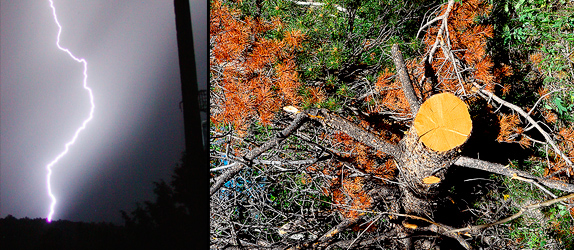
The long 21st century drought seems finally to be catching up to the East Mountains. For years we’ve managed to avoid its worst consequences. Life has gone along, year after year, pretty much normally. But now it may be time to pay the piper.
The wells of my local water co-op are running dry. A large, well established and ably managed utility with several hundred members, it has long had four deep wells. One, however, has just run dry and another is imperiled. A letter to co-op members last week pleaded for major voluntary conservation efforts, including a total ban on outdoor watering; if these efforts are insufficient, mandatory conservation is in the offing. This is the direst situation in my 24 years with the co-op.
Recognizing the seriousness of the problem, New Mexico’s two senators have introduced a bill that would appropriate $100 million for rural areas, primarily to help farmers and small businesses cope with the drought.
Almost daily I drive past the ponderosas lining South 14. Most of these beautiful, towering, trees, with their straight trunks and high branches, are dead or dying. At lower altitude closer to Tijeras, some piñons and junipers are suffering the same fate.
For the first time this summer, last week I drove up through the Sandias to the Crest House. My wife Thelma and I walked several miles along the Nature Trail and the Crest Trail, across the Kiwanis Meadow and to the Kiwanis Cabin, then had a beer at the High Finance Restaurant at the tram while the sun slid behind the western volcanoes. Afterward, we walked the two miles of trails back to our car. The large, full honey moon of June hovered at my right shoulder, Thelma at my left. The forest soared on either flank. A hundred miles of New Mexico desert, bosque and mountains lay vast and silent west of the trail and trees.
It would have been a halcyon outing had it not been for the dead, dying and diseased trees lining the road, filling the hillsides and littering the forest floor beside the trails, where hundreds of trunks of white fir and aspen had been felled to avoid having them fall on unsuspecting hikers. In localized areas, more than half the trees are dead.
When I told Sandia District Ranger Cid Morgan I had just driven through the Sandias for the first time this season, her first words were, “Were you shocked?” I was indeed.
Morgan said Friday she is developing a vast and expensive plan to reduce the vegetation on 20,000 acres in the Sandias. But she said they can’t legally undertake similar treatment on the 38,000 acres of the Sandia Wilderness. There, the only remedy permitted by law is prescribed burns, “and there is no way I’m going to introduce fire into that area,” Morgan said. “No way!”
Memories among forest rangers are still vivid of the prescribed burn by the Santa Fe National Forest that blew out of control in the Jemez Mountains, destroyed much of the city of Los Alamos and nearly wiped out Los Alamos National Laboratory.
In recent years, three major wildfires have scoured out the Manzanos, and twice wildfires ignited on Kirtland Air Force Base have spilled over the ridge to the east in the Manzanitas. But there has been no major wildfire in the Sandias in modern times. When a small fire has started, it has been quickly extinguished due to the danger to nearby houses.
Morgan said the tragedy in the forest is the result of a combination of factors. One, but only one, is the drought. Exactly when the drought began for you depends on the microclimate in which you live. In my neighborhood, in the Manzanita Mountains, it began in 1997 and, with only sporadic relief, has lasted for 17 years. Winters that brought three-foot snows and monsoon rains that flooded roads and turned arroyos into churning streams are now only memories.
A second factor is that the drought has weakened trees, leaving them vulnerable to diseases, now especially flat headed wood borers attacking junipers and white fir beetles.
Third, drought and disease together are making the forest especially vulnerable to wildfire. If there were lightning strikes among dead groves in the Sandias, as is entirely possible in the next several weeks, a wildfire could quickly ignite and transmute into a blistering crown fire destroying all in its path. In a prelude to the storms of the monsoon season, which usually begins in early July, numerous lightning bolts flashed over the East Mountains recently. Two weeks ago, lightning sparked a small wildfire in Los Pinos Mountains south of Abó.
Fourth, unusually wet weather beginning in the 1960s, after the terrible drought of the 1950s, encouraged dense, rapid growth in the forest, growth that the drier climate of the past two decades has been unable to perpetuate.
Finally, fifth, what is transforming routine wildfire danger into the prospect of human and environmental disaster, Morgan said, has been the Forest Service’s “misguided” past policy of total fire suppression. Without fire to allow the forest to self-regulate, the density of vegetation has multiplied geometrically, to the point that the forest cannot sustain itself in times of drought and cannot survive fire.
The Forest Service is trying to reverse that policy, but it is like trying to stop a 100-car freight train: Change requires not months but years, not a few dollars but millions. The plan to reduce vegetation on 20,000 acres has been in preparation for three years and won’t be ready to present to the public until early next year. Meanwhile the ranger district is moving ahead with a plan to reduce vegetation on a 1,100-acre tract near two campgrounds.
There is a molecule of good news. The early months of this year have been wetter than the same period last year. A survey of live trees a week ago showed, to Morgan’s surprise, moisture was 10 percent above critical levels. Whether the forest will again be closed remains uncertain. “It all depends on what happens with rain in the next few weeks,” Morgan said. The 10-day weather forecast, however, shows the likelihood of rain at zero to 10 percent.
So what we have in the East Mountains, as in many forested areas throughout the West, is a poisoned meal that has been prepared over many years and is now set before us. The chefs are misguided mankind and unforgiving nature. The diners are we ourselves. Unless we are very, very lucky, indigestion, or worse, awaits.
(Photos: Lightning by Thelma Bowles, dry vegetation by Bob Shrader)



Responses to “Drought: time to pay the piper”